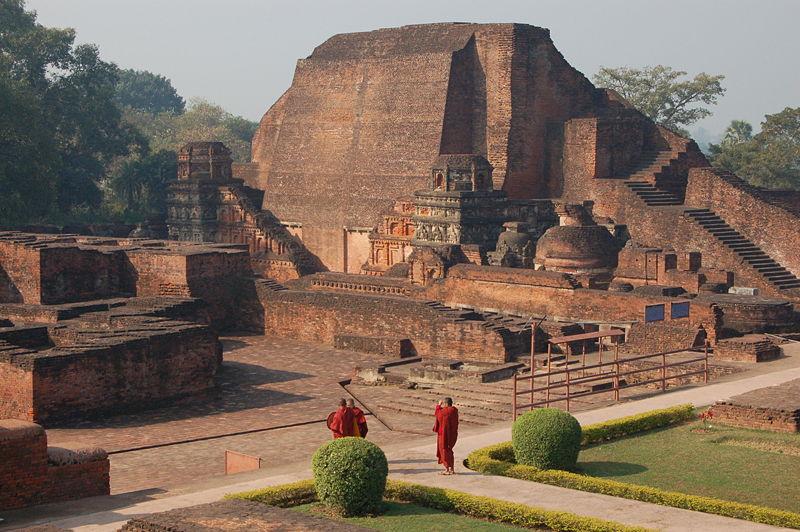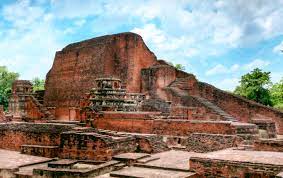Nalanda, an illustrious institution of ancient India, stands as a historic epicenter of advanced education located in Bihar, India. Established in AD 427 in the northeastern part of India, near the present-day southern border of Nepal, this renowned university continued its educational legacy until AD 1197. While its primary focus lay in the realm of Buddhist studies, it also offered a wide spectrum of education, encompassing fine arts, medicine, mathematics, astronomy, politics, and military strategy. This article serves as a comprehensive exploration of Nalanda University. History of Nalanda University

History of Nalanda University
Nalanda, an ancient center of higher learning in Bihar, India, holds a remarkable history spanning from 427 to 1197 AD. Founded in the 5th century AD, this prestigious institution, situated in northeastern India not far from the current southern border of Nepal, stood as a beacon of knowledge and wisdom.
Initially dedicated to Buddhist studies, Nalanda University evolved over time to encompass a diverse curriculum, including fine arts, medicine, mathematics, astronomy, politics, and the art of warfare. Its sprawling campus featured eight separate compounds, ten temples, meditation halls, classrooms, serene lakes, and lush parks.
Who Built Nalanda University?
Nalanda University was founded during the reign of the Gupta dynasty by Kumaragupta I, often referred to as Kumaragupta I (also known as Kumaragupta the Great). Kumaragupta I was a notable Gupta emperor who ruled during the 5th century CE. He is credited with the establishment of Nalanda University in Bihar, India, around the early 5th century AD. Kumaragupta I’s patronage and support played a crucial role in the foundation and development of this prestigious institution. However, it was under the patronage of his successors, particularly King Harsha, that Nalanda flourished and reached its zenith. The university received generous grants and support from various rulers, which contributed to its growth and reputation.
Why Nalanda University is Famous?
Nalanda University gained fame not only for its sheer size but also for its commitment to academic excellence. It boasted a vast library, known as the “Dharma Gunj,” which housed countless scrolls, manuscripts, and texts from different parts of the world. This library was a treasure trove of knowledge and played a pivotal role in the dissemination of wisdom across borders.
Moreover, Nalanda was home to renowned scholars such as Nagarjuna, Aryadeva, and Dharmapala, whose contributions to Buddhism and other fields of study are still revered today. The university’s intellectual and cultural exchange between scholars of different backgrounds enriched its academic environment.
Attacks on Nalanda University
Nalanda University, a symbol of ancient Indian knowledge and scholarship, faced two notable attacks during its history.
The first attack occurred between 455 and 470 AD when the Hunas, a Central Asian tribal group, invaded Nalanda during the reign of Emperor Samudragupta of the Gupta Empire. The motive behind this attack was primarily plunder, as the Hunas sought to loot the university’s valuable resources. Although the damage was not severe, Skanda Gupta, another Gupta Emperor, re-established the university, and during his reign, the renowned Nalanda library was founded.
The second attack transpired in the early 7th century when Goudas Rajvansh, the emperor of Bengal, targeted Nalanda due to political tensions with Emperor Harshavardhana of Kannauj. The attack was motivated by political rivalry, leading to some destruction. However, Harshavardhana’s efforts led to the university’s restoration, enabling Nalanda to continue its mission of global knowledge dissemination. These incidents, while disruptive, underscore Nalanda’s enduring legacy as a center of learning.
Ancient Nalanda University’s Destruction
In 1193 AD, Nalanda University suffered a devastating attack by Bakhtiyar Khilji, a general serving under Qutubuddin Aibak. Unlike previous attacks on the university, this invasion was particularly fatal, and it marked the end of Nalanda’s prominence as a center of learning.
The motivation behind Bakhtiyar Khilji’s assault on Nalanda was not political but rather personal. It is recounted that Khilji was in poor health and had sought medical help from various practitioners without success. Desperate for a cure, he turned to Rahul Sri Bhadra, the principal of Nalanda University at the time, who successfully treated him. However, Khilji’s sense of insecurity grew as he felt threatened by the knowledge possessed by Indian scholars, particularly in the field of Ayurveda. In an attempt to eliminate this perceived threat, he decided to destroy Nalanda University.
The destruction wrought by Bakhtiyar Khilji’s attack was catastrophic. His primary target was the university’s library, which housed an astonishing collection of approximately 90 lakh (9 million) books and manuscripts. He set fire to the library, and historians estimate that it took three months to burn down this repository of knowledge completely. In addition to the destruction of the library, Bakhtiyar Khilji mercilessly killed the monks and scholars residing within the university. His intent was to prevent the transmission of knowledge from one generation of scholars to the next.
The devastation inflicted upon Nalanda University during this attack was so profound that it marked the end of an era. Subsequent rulers were unable to restore the institution to its former glory, and the flow of knowledge from Nalanda came to a tragic and irreversible halt. This tragic event remains a poignant reminder of the fragility of human knowledge and the consequences of cultural and intellectual destruction.
Nalanda University Library
The library of the ancient Nalanda University is referred to as Dharmaganja (also written as Dharma Gunj) by traditional Tibetan sources, and loosely translates to “Treasury of Truth.”This grand edifice had the remarkable capacity to house an astounding 90 lakh (9 million) books and manuscripts. Such was its vastness that during the devastating invasion led by Bakhtiyar Khilji, it tragically took three long months for this immense repository of knowledge to be completely consumed by flames. The loss of Dharma Gunj and its invaluable collection remains a somber testament to the destruction of an irreplaceable treasure trove of ancient wisdom and scholarship.
Nalanda University Reconstruction
The reconstruction of Nalanda University in the modern era is a remarkable and ambitious endeavor aimed at reviving the legacy of this ancient center of learning. Here is an overview of the reconstruction of Nalanda University:
Idea and Inception: The idea of reviving Nalanda University was first mooted by the former President of India, Dr. A.P.J. Abdul Kalam, in 2006 during his address to the Bihar State Legislative Assembly. Simultaneously, the Singapore government proposed the “Nalanda Proposal” to the Indian government, suggesting the re-establishment of Nalanda as a prominent educational institution.
Government Initiatives: The Government of India, along with the State Government of Bihar, played a pivotal role in the reconstruction of Nalanda University. A suitable location for the new university campus was identified, comprising 450 acres of land at the base of the scenic Rajgir Hills in Bihar.
International Support:
Recognizing the historical significance of Nalanda and its potential as a modern center of learning, leaders from sixteen member states of the East Asia Summit (EAS) endorsed the proposal to re-establish Nalanda University. This international support underscored the importance of this initiative on a global scale.
Nalanda University Act: The project took a significant step forward when the Nalanda University Act 2010 was passed in both houses of the Indian Parliament. This act provided the legal framework for the establishment and functioning of the new Nalanda University.
Inauguration and Enrollment: In September 2014, Nalanda University opened its doors for the first batch of students, marking a historic moment after a gap of nearly eight centuries. The new university focused on interdisciplinary studies and global collaboration, embodying the spirit of its ancient predecessor.
Contemporary Focus:
The revived Nalanda University aims to carry forward the essence of the original institution by fostering an environment of diverse learning, research, and international cooperation. It focuses on a wide range of academic disciplines and encourages scholars and students from across the world to engage in collaborative knowledge creation.
Recognition: Nalanda University has been recognized as an “Institute of National Importance” by the Government of India, highlighting its critical role in modern education and research.
The reconstruction of Nalanda University serves as a testament to the enduring value of education and the preservation of intellectual heritage. It strives to recapture the spirit of ancient Nalanda while adapting to the needs and challenges of the contemporary world, making it a symbol of India’s commitment to education and global collaboration.
Nalanda University’s current status
Nalanda University (NU) presently operates from its temporary campus located in Rajgir, Bihar. Additionally, the university utilizes the Rajgir International Convention Centre, an impressive facility equipped with diverse auditoriums, seminar rooms, an art gallery, a cinema theater, and a cafeteria.
Nalanda University’s legacy
Nalanda University’s legacy is a testament to intellectual excellence, interdisciplinary learning, and global outreach. Established in the 5th century AD, it attracted scholars and students from across the world, fostering cultural exchange and knowledge dissemination. The university’s legendary library, the “Dharma Gunj,” symbolized the importance of preserving and sharing knowledge. Despite facing adversity, Nalanda demonstrated resilience and continued its mission of education. Its revival in the modern era underscores the enduring legacy of this ancient institution. Nalanda’s influence inspires scholars and institutions worldwide, serving as a symbol of human curiosity and the pursuit of enlightenment.
History of Nalanda University History of Nalanda University History of Nalanda University Nalanda University in hindi location of Nalanda University Nalanda University address Nalanda University History in hindi Nalanda University in hindi location of Nalanda University Nalanda University address Nalanda University History in hindi Nalanda University in hindi location of Nalanda University Nalanda University address Nalanda University History in hindi Nalanda University in hindi location of Nalanda University Nalanda University address Nalanda University History in hindi Nalanda University in hindi location of Nalanda University Nalanda University address Nalanda University History in hindi






